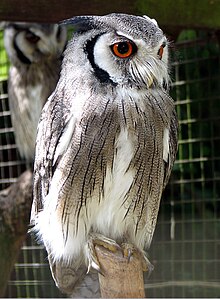The northern white-faced owl (Ptilopsis leucotis) is a species of owl in the family Strigidae. The southern white-faced owl (P. granti) was formerly included in this species and the two were known as the white-faced scops-owl.
| Northern white-faced owl | |
|---|---|

| |
| Scientific classification | |
| Domain: | Eukaryota |
| Kingdom: | Animalia |
| Phylum: | Chordata |
| Class: | Aves |
| Order: | Strigiformes |
| Family: | Strigidae |
| Genus: | Ptilopsis |
| Species: | P. leucotis
|
| Binomial name | |
| Ptilopsis leucotis (Temminck, 1820)
| |
| Synonyms | |
|
Otus leucotis | |
It is found in a band across Africa between the Sahara and the Equator. It occurs in Benin, Burkina Faso, Cameroon, Central African Republic, Chad, Republic of the Congo, Ivory Coast, Djibouti, Eritrea, Ethiopia, Gambia, Ghana, Guinea, Guinea-Bissau, Kenya, Liberia, Mali, Mauritania, Niger, Nigeria, Senegal, Sierra Leone, Somalia, Sudan, Togo and Uganda.
Fight-or-flight response
editThis owl has a rather notable defense mechanism. When faced with a similar-sized predator (like another owl slightly larger than it), the bird flares its wings to appear larger. When faced with something much larger than itself (such as an eagle), it pulls its feathers inwards, elongates its body, and narrows its eyes to thin slits. It is thought that it uses this ability to camouflage itself,[3][4] and it shares the ability with relatives like the African scops owl.[5]
Many different types of owls have some ability to adopt a "concealing posture", also known by the German word Tarnstellung,[6] in which they squeeze and thin their body to look like a broken tree branch, and some types may also narrow their eyes to slits and fold a wing sideways across their chest in a Dracula-like manner to hide the lighter-colored feathers on their underparts.[7] Such behavior has also been documented in Eastern screech owls in a natural setting reacting to threats.[8]
In popular culture
editA member of this species named "Popo-chan" was the subject of a Japanese television show, during which the species' concealing posture was demonstrated.[9][10]
References
edit- Sinclair, Ian & Ryan, Peter (2003) Birds of Africa south of the Sahara, Struik, Cape Town.
- ^ BirdLife International (2016). "Ptilopsis leucotis". IUCN Red List of Threatened Species. 2016: e.T61781834A95179876. doi:10.2305/IUCN.UK.2016-3.RLTS.T61781834A95179876.en. Retrieved 17 November 2021.
- ^ "Appendices | CITES". cites.org. Retrieved 14 January 2022.
- ^ Discussed in the "Habits" section of Northern White-faced Owl's entry in Owls of the World by Claus König and Friedhelm Weick (2008). p. 315.
- ^ "White faced Scops owl" from the website of the Bronx Zoo.
- ^ Newman's Birds of Southern Africa by Kenneth Newman (2002), p. 238.
- ^ North American Owls: Biology and Natural History by Paul A. Johnsgard (1988), p. 63
- ^ Owls by Cynthia Berger (2005), p. 42-43.
- ^ See YouTube video Wild Transformer Owls - New and Natural! for same behavior exhibited by eastern screech owls
- ^ See youtube video Popo-chan for the full segment, or the edited version Transformer Owl. Accessed 20 April 2012.
- ^ Popo-chan is housed in a Japanese bird and flower park called Kakegawa Kachoen which has a Japanese-language website here, with an English translation of the page by google found here (the park also has an English-language website which mentions "Popo the White-faced Scops Owl" here but does not identify the precise species). In the "Here are the highlights" section of the translated version there is a line translated as "famous in Japan in the mimicry Owl Giant African Scops of Popo Chan", and the "Giant African Scops" link takes readers to a page on Ptilopsis leucotis, the scientific name for the Northern White-faced Owl.
External links
edit- Northern white-faced owl - Species text in The Atlas of Southern African Birds.
